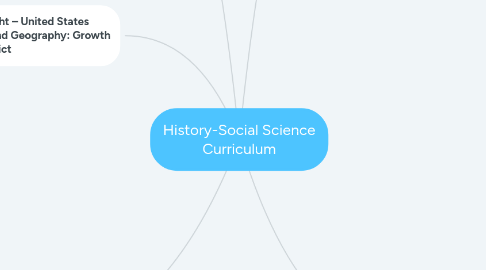
1. Content
1.1. History
1.1.1. 8.1.1 Describe the relationship between the moral and political ideas of the Great Awakening and the development of revolutionary fervor.
1.1.2. 8.4.2 Explain the policy significance of famous speeches (e.g., Washington’s Farewell Address, Jefferson’s 1801 Inaugural Address, John Q. Adams’s Fourth of July 1821 Address).
1.1.3. 8.7.2 Trace the origins and development of slavery; its effects on black Americans and onthe region’s political, social, religious, economic, and cultural development; andidentify the strategies that were tried to both overturn and preserve it (e.g., throughthe writings and historical documents on Nat Turner, Denmark Vesey).
1.2. Geography
1.2.1. 8.5.2 Know the changing boundaries of the United States and describe the relationships thecountry had with its neighbors (current Mexico and Canada) and Europe, includingthe influence of the Monroe Doctrine, and how those relationships influenced westward expansion and the Mexican-American War.
1.2.2. 8.8.4 Examine the importance of the great rivers and the struggle over water rights.
1.2.3. 8.10.2 Trace the boundaries constituting the North and the South, the geographicaldifferences between the two regions, and the differences between agrarians andindustrialists.
1.3. Economics
1.3.1. 8.5.1 Understand the political and economic causes and consequences of the War of 1812and know the major battles, leaders, and events that led to a final peace.
1.3.2. 8.7.1 Describe the development of the agrarian economy in the South, identify the locationsof the cotton-producing states, and discuss the significance of cotton and the cotton gin.
1.3.3. 8.12.3 Explain how states and the federal government encouraged business expansionthrough tariffs, banking, land grants, and subsidies.
2. Citizenship
2.1. Civics and Government
2.1.1. 8.3.4 Understand how the conflicts between Thomas Jefferson and Alexander Hamiltonresulted in the emergence of two political parties (e.g., view of foreign policy, Alien andSedition Acts, economic policy, National Bank, funding and assumption of the revolutionary debt).
2.1.2. 8.3.6 Describe the basic law-making process and how the Constitution provides numerousopportunities for citizens to participate in the political process and to monitor andinfluence government (e.g., function of elections, political parties, interest groups).
2.1.3. 8.6.6 Examine the women’s suffrage movement (e.g., biographies, writings, and speeches ofElizabeth Cady Stanton, Margaret Fuller, Lucretia Mott, Susan B. Anthony).
2.1.4. 8.9.6 Describe the lives of free blacks and the laws that limited their freedom and economicopportunities.
2.1.5. 8.10.3 Identify the constitutional issues posed by the doctrine of nullification and secessionand the earliest origins of that doctrine.
3. Grade Eight – United States History and Geography: Growth and Conflict
4. Inquiry
4.1. 8.2.3 Evaluate the major debates that occurred during the development of the Constitutionand their ultimate resolutions in such areas as shared power among institutions, divided state-federal power, slavery, the rights of individuals and states (later addressedby the addition of the Bill of Rights), and the status of American Indian nations underthe commerce clause.
4.1.1. H-SS AS: Students should consider topics that divided the Founding Fathers and examine compromises they adopted to produce a unifying document.
4.2. 8.4.1 Describe the country’s physical landscapes, political divisions, and territorial expansion during the terms of the first four presidents.
4.2.1. H-SS AS: Students can relate this back to a debate over strict versus loose construction interpretation of the Constitution as they consider the question, Was the Louisiana Purchase Constitutional?
4.3. 8.6.1 Discuss the influence of industrialization and technological developments on theregion, including human modification of the landscape and how physical geographyshaped human actions (e.g., growth of cities, deforestation, farming, mineral extraction).
4.3.1. H-SS AS: Students can compare the regions in terms of commercial development, sources of wealth, natural resources, political agendas, religious and ethnic diversity, infrastructure, population density, and eventually slavery, including the debate over the free soil movement.
4.4. 8.6.6 Examine the women’s suffrage movement (e.g., biographies, writings, and speeches of Elizabeth Cady Stanton, Margaret Fuller, Lucretia Mott, Susan B. Anthony).
4.4.1. H-SS AS: Students can begin with a brief review the legal and economic status of women and learn about the major impetus given to the woman’s rights movement by leaders such as Susan B. Anthony and Elizabeth Cady Stanton. They should read and discuss the Seneca Falls Declaration of Sentiments and compare it with the Declaration of Independence by revisiting the important question: What did freedom mean and how did it change over time?
4.5. 8.9.1 Describe the leaders of the movement (e.g., John Quincy Adams and his proposedconstitutional amendment, John Brown and the armed resistance, Harriet Tubmanand the Underground Railroad, Benjamin Franklin, Theodore Weld, William Lloyd Garrison, Frederick Douglass).
4.5.1. H-SS AS: Excerpts from Frederick Douglass’s What the Black Man Wants, David Walker’s Appeal, Harriet Beecher Stowe’s Uncle Tom’s Cabin, and Fanny Kemble’s Journal of Residence on a Georgia Plantation, as well as excerpts from slave narratives and abolitionist tracts of this period, will bring these people and events alive for students and enable them to address questions like: How did people work to end slavery and what opposition did they face?

